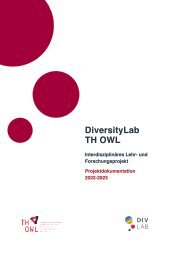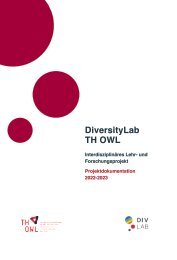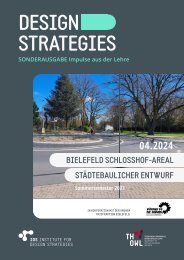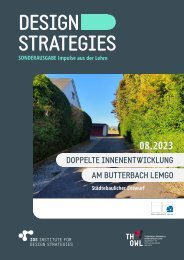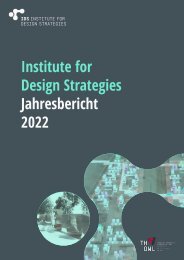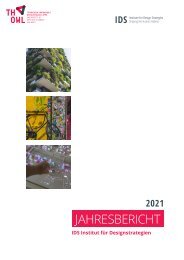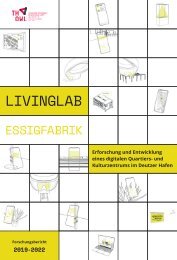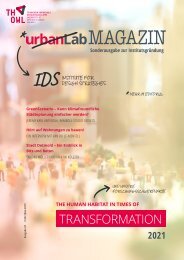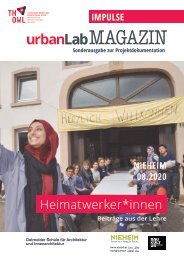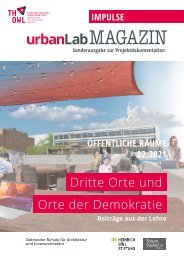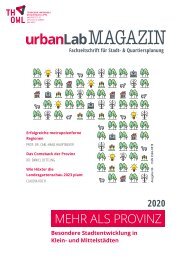Design Strategies IMPULSE - Sustainable Facades Vol 2
Report Winter Semester 2023/24
Report Winter Semester 2023/24
Create successful ePaper yourself
Turn your PDF publications into a flip-book with our unique Google optimized e-Paper software.
1. INTRODUCTION<br />
As the title <strong>Sustainable</strong> Façades declares, the focus<br />
of this report is on “façades”, which generally refer<br />
to the vertical surfaces of the building envelope,<br />
including the walls, doors, windows, balustrades,<br />
balconies, parapets and depending on the case,<br />
possibly parts of the roof (Knaack et al., 2007; Klein,<br />
2013), and how they impact the people inside and<br />
outside of buildings, as well as the environment<br />
and the economy. <strong>Sustainable</strong> practices can be<br />
integrated into multiple stages of projects, including<br />
the design, construction, use, maintenance, and<br />
end-of-life stage of buildings. However, determining<br />
the sustainability of a project is a complex task,<br />
given its wide-ranging implications.<br />
The cover of this magazine shows the façade of the<br />
Schüco One building in Bielefeld designed by 3XN<br />
Architects, the first building in the world to receive<br />
all three sustainability certifications from the LEED,<br />
BREEAM and DGNB labels. This sets a precedent<br />
in the construction industry but also highlights<br />
some conceptual differences between labels. For<br />
example, the BREAM category “pollution” differs<br />
from the LEED v.4.1. scorecard for Building <strong>Design</strong><br />
and Construction, which is the most popular<br />
worldwide (Chomsky, 2023) since LEED doesn’t<br />
account for potential unintended by-products of<br />
the building, showing how BREAM is more flexible<br />
to unexpected circumstances.<br />
The controversial case of the 20 Fenchurch Street<br />
skyscraper – the “walkie talkie” in London can<br />
exemplify how the BREAM covers an aspect that<br />
could be neglected by other labels. As it became<br />
well known, the concave façade acted as a mirror<br />
reflecting sunbeams to the street, leading to<br />
material damage (Smith-Spark, 2013). The project<br />
was applying for BREAM certification, and it was<br />
put on hold until the developers solved the issue<br />
by installing a brise-soleil to diffuse the reflected<br />
sunlight and prevent further damage. Afterwards,<br />
the certification was restored and it has since then<br />
become an iconic project in the skyline of London.<br />
When focusing on the requirements for adequate<br />
façade performance it is clear that the criteria<br />
are probably not the same in every project,<br />
therefore façade performance is contextdependent.<br />
According to Bianchi et al. (2024)<br />
façade performance can be classified into<br />
three main performance categories: Functional,<br />
Environmental, and Financial. These categories<br />
correspond to the three pillars of the triple<br />
bottom line (Society, Environment, Economy).<br />
Therefore, raising the idea that for a façade to<br />
be sustainable, it should perform adequately in<br />
those three aspects. The functional performance<br />
category includes structural safety, human comfort<br />
(including air quality, thermal, acoustic and visual<br />
comfort), and durability as the main criteria.<br />
Environmental performance includes energy and<br />
material efficiency, considering not only energy<br />
demand, generation and storage, but also carbon<br />
footprint and biodiversity impacts. The financial<br />
performance category is focused on the initial,<br />
operational and end-of-life costs. This overview of<br />
performance criteria helps identify the potential<br />
performance of a specific project, however,<br />
this classification does not exclude overlapping<br />
between categories.<br />
Considering these issues, as explained in the<br />
first edition of <strong>Sustainable</strong> Façades, the goal of<br />
this report is to explore the possible meanings<br />
of sustainability within the built environment,<br />
examining façades as intrinsic elements of every<br />
building and every city. This introduction is followed<br />
by the next sections:<br />
Section 2 | Latest Research is a showcase of<br />
recent publications by members of the academic<br />
network of TH OWL. In this edition, we have<br />
a summary of the PhD thesis of Dr.-Ing. Anica<br />
Dragutinovic, focused on the deterioration and<br />
management challenges of post-war mass housing<br />
neighborhoods, exemplified by New Belgrade<br />
Blocks. It explores how ownership changes and<br />
community dynamics affect these areas. The study<br />
applied participatory methods to develop a valuesbased<br />
intervention framework for these spaces,<br />
promoting inclusive heritage management, and<br />
contributing to residents‘ sense of belonging.<br />
Section 3 | Articles presents original work<br />
developed recently that has not been published<br />
elsewhere. This section includes two Master<br />
6<br />
INTRODUCTION<br />
<strong>Design</strong> <strong>Strategies</strong> <strong>IMPULSE</strong> – <strong>Sustainable</strong> Façades 04.2024<br />
7





